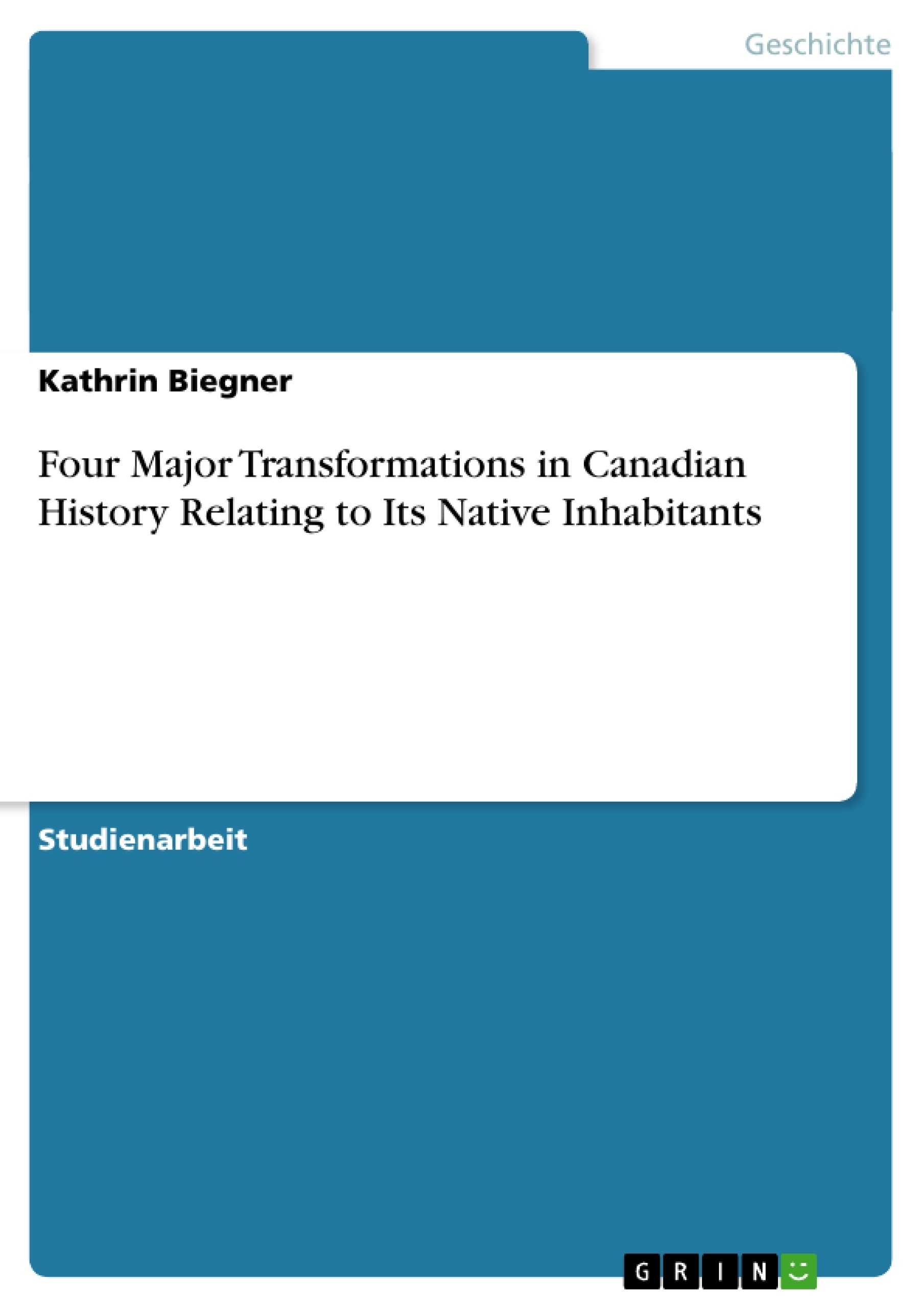History explains the past. Dealing with the past, everybody quickly realizes that there are some things that have changed and some that have remained the same. There are certain periods in history when rapid changes occur and others when time seems to stand still. Often periods of transformation are triggered by technical developments, changing natural circumstances, or new ideologies. These affect each other and create a new situation. In Canadian history, all of these components initiated transformations and we can interpret these transformations ourselves.
H. V. Nelles explains in A Little History of Canada where he sees major transformation in Canadian history. After presenting these in a short analysis, I will show another structure which emphasizes four major transformations that relate to Native Canadians. The first transformation occurred before 1500 when Canada became inhabited by its indigenous nations. Afterwards France transformed the continent until her defeat in 1763. This was the end of the fierce competition between Britain and France which meant Natives could no longer take advantage of their position as military allies. Under British rule the third period of transformation started and a new state formed in 1867: the Dominion of Canada. The British continued to strongly influence Canada throughout the industrialization and Victorian Age. All over this time Natives were oppressed. The fourth transformation started when Natives were allowed to fight for Canada, their home country, during the First World War.
Inhaltsverzeichnis
- Introduction
- Major Transformations of Canadian History According to Nelles
- Becoming Home to Native Nations
- Scholars estimate different dates for the migration of the first humans to the North American continent ranging from 50,000 BC to 10,000 BC.² Most likely the first immigrants travelled from Siberia via the land bridge Beringia which connected the Asian and American continents during the ice ages.³ Some scholars also state that these earliest immigrants might have sailed.
- Other developments had more impact on Natives' lives.
- In the Arctic, the Thule started to supersede the Dorset in 1,000 AD.
- Increasing in population since the fourteenth century, by 1451 the Iroquoian peoples Mohawk, Oneida, Onondaga, Cayuga, and Seneca formed the League of Five Nations to keep peace among themselves.
- European Fights in the New World
- After having lived for 14,900 years without continuous contact with Europeans on the North American continent, Natives were again confronted with European invaders in the fifteenth century - and this time the Europeans decided to stay.
- The first to arrive in present-day Canada during this period was Giovanni Caboto under the British flag.
- The relationship between the indigenous peoples and the newcomers was unequal due to the Europeans' possession of guns.
- An important role was played by Native women.
Zielsetzung und Themenschwerpunkte
Der Text untersucht die Geschichte Kanadas, wobei der Fokus auf die Transformationen liegt, die das Land durchlaufen hat. Dabei werden die Perspektiven der indigenen Völker und der europäischen Kolonialmächte berücksichtigt.
- Die Besiedlung Kanadas durch indigene Völker
- Die Ankunft der Europäer und die Auswirkungen auf die indigene Bevölkerung
- Die Rolle der indigenen Frauen in der Geschichte Kanadas
- Die Entwicklung des Kolonialismus in Kanada
- Die Bedeutung der Transformationen für das heutige Kanada
Zusammenfassung der Kapitel
Das erste Kapitel behandelt die Besiedlung Kanadas durch indigene Völker, die sich über Jahrtausende erstreckte. Es werden die verschiedenen indigenen Kulturen, ihre Lebensweise und ihre sozialen Strukturen beleuchtet. Das zweite Kapitel beschreibt die Ankunft der Europäer in Kanada und die Folgen für die indigenen Völker. Es werden die Konflikte zwischen den Europäern und den indigenen Völkern, die Auswirkungen der europäischen Krankheiten und die Rolle des Pelzhandels thematisiert. Das dritte Kapitel befasst sich mit der Entwicklung des Kolonialismus in Kanada und den Veränderungen, die er für die indigene Bevölkerung mit sich brachte. Es werden die Rolle der französischen und britischen Kolonialmächte, die Beziehungen zwischen den indigenen Völkern und den Kolonialmächten sowie die Rolle der indigenen Frauen im Pelzhandel behandelt.
Schlüsselwörter
Indigene Völker, Kolonialismus, Pelzhandel, Transformationen, Geschichte Kanadas, indigene Frauen, europäische Krankheiten, Kulturkontakt.
- Citar trabajo
- Kathrin Biegner (Autor), 2008, Four Major Transformations in Canadian History Relating to Its Native Inhabitants, Múnich, GRIN Verlag, https://www.grin.com/document/169428
-

-

-

-
¡Carge sus propios textos! Gane dinero y un iPhone X. -

-
¡Carge sus propios textos! Gane dinero y un iPhone X. -

-
¡Carge sus propios textos! Gane dinero y un iPhone X. -

-
¡Carge sus propios textos! Gane dinero y un iPhone X. -

-
¡Carge sus propios textos! Gane dinero y un iPhone X. -

-
¡Carge sus propios textos! Gane dinero y un iPhone X.

